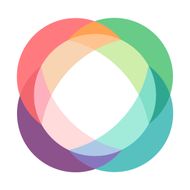Hi! I’m Caroline Sinders (Caro for short); I’m a human rights researcher, and artist, originally from New Orleans, Louisiana and now based in the midwest, with long stints in London and Berlin in between. I’ve worked with organizations like the UN, the Information Commissioner’s Office (the UK’s data protection and privacy regulator), Amnesty International, the Mozilla Foundation, the Wikimedia Foundation, the Harvard Kennedy School and others. As an artist, I’ve worked with or had my work shown with the Tate Exchange in the Tate Modern, the Photographer's Gallery, MoMA PS1, the Contemporary Art Center of New Orleans, Honor Fraser Gallery, Ars Electronica, Drugo More, the European Media Art Platform, the European Commission's Sci Art residency, Eyebeam and others.
Focusing on Harm in Design
I’m so excited to be an Interledger Ambassador with the 2025 cohort, and to be exploring a topic really close to my heart: harmful design patterns. Harmful design patterns, sometimes called ‘dark patterns’, ‘manipulative design’, ‘deceptive design’, ‘anti-patterns’, or ‘online choice architecture’, are all the same phenomena which are design patterns that unintentionally or intentionally trick, confuse, or nudge users into making decisions they normally wouldn’t make. If you are reading this and thinking, “I don’t think I’ve come across a harmful design pattern before,” the sad truth is that you have :/
Have you ever unsubscribed from a newsletter and found you’re still subscribed? Have you ever booked a seat on a budget airline and realized you were ‘nudged’ or ‘directed’ to purchase add ons you didn’t really need, or have you ever clicked on a cookie banner? You have encountered a harmful design pattern, but there are hundreds of different types.
I’ve written about harmful design patterns before, as a post-doctoral fellow with the UK’s data protection and privacy regulator, the ICO, in a collaboration with the UK’s competitions and markets authority, which you can read here in this collaborative paper of which I am one of the co-authors. I’ve also investigated harmful design patterns in subscriptions, and tracked how much money and time I lost, which you can also read about here. I’ve also presented at CHI on the emerging threats about harmful design patterns, worked with German’s Interface think tank on contextualizing harmful design patterns for German regulators, diving deep into design as a medium and how that impacts harmful design for the German Marshall Fund, and many other articles on this topic.
What can be done to tackle harmful design patterns? I’m so glad you asked, because there are so many things that can be done. Regulators are taking action against harmful design patterns across the globe, with India having passed regulation against harmful design patterns, the European Commission prohibiting dark patterns in the Digital Services Act, and regulators in the US and UK using pre-existing laws to combat dark patterns. But, supporting new research and investigations along with educating consumers, technologists and designers are incredibly helpful in identifying new harmful design patterns, and combating them from the ground up.
My Interledger Ambassador Project
Which brings us back to my project :) I’m creating new research and focusing on harmful design patterns that exist within banking, finance, and money lending apps. A lot of current harmful design patterns work has focused on money-spending and e-commerce; my theory is that its a bit easier for consumers to track how they spend money, especially if they are charged for something they didn’t intend to buy (via a harmful design pattern). But, I’m curious about the unforeseen fees, and predatory lending within harmful money apps, and juxtaposing that by focusing on best practices within money transferring and money lending apps. In other harmful design patterns contexts, I often argue friction can exacerbate a harmful design pattern. But we need friction in banking and money lending apps to ensure a consumer doesn’t make a financial ‘accident’ of sending money to the wrong person, for example. By studying best practices, I hope to establish the necessary design patterns needed for banking, finance and money lending apps, and then also identify the harmful design patterns.
This project aims to provide those building new digital financial services with an awareness of how to ensure they are being inclusive by design and how to avoid even unintentional harm when working in a particular context or with a specific demographic of users. By surfacing, documenting, and naming these examples of harmful design, I believe we can strengthen digital financial inclusion by ensuring that software and design are as equitable and easier to use for everyone as possible.
If you have any thoughts, feedback or would like to be involved, or just chat, please reach out :)


Top comments (0)